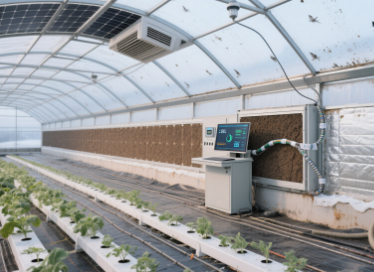When temperatures drop and snow begins to pile up, your greenhouse becomes more than just a growing space—it becomes a critical line of defense against the cold. Without proper insulation and smart design, energy costs rise and crops struggle to survive.
So, how can you build a winter greenhouse that truly holds in the heat while keeping operating costs down? From materials to structure and climate control, this guide covers the key elements for designing an efficient and well-insulated winter greenhouse.
Choosing the Right Insulation Materials
The first step to effective insulation is selecting the right covering. Polycarbonate panels have become a popular choice for cold-climate greenhouses. Their multi-wall design traps air between layers, reducing heat loss while still allowing good light transmission. These panels are also highly durable, resisting impacts from hail and snow.
Another option includes double-layer polyethylene film paired with an inflation system. The air gap between layers serves as insulation, making this a practical solution for growers who need flexible or budget-conscious builds.
Chengfei Greenhouse has implemented polycarbonate panel systems in northern regions, with designs that incorporate tight seals and high-efficiency structures. These greenhouses maintain steady internal temperatures even during freezing nights.
Structural Design Affects Heat Retention
The greenhouse frame plays a bigger role in insulation than most realize. Metal frames, especially those with uninsulated joints, can act as thermal bridges that leak heat. Reducing exposed metal and using thermal breaks at key connection points can dramatically improve heat retention.
Roof slope also matters. A sloped roof not only prevents snow buildup but also improves solar gain during the day. South-facing roofs with an optimal angle help capture maximum sunlight during the short winter days.

Air Tightness Is Non-Negotiable
Even the best materials fail if the greenhouse isn’t airtight. Cracks around doors, windows, or structural joints allow warm air to escape and cold air to enter. Doors and vents should have double seals, and foundation joints should be sealed with weather-resistant insulation strips or foam. Adding an insulated foundation skirt around the base of the structure can block cold air from seeping in from below.
Thermal Screens Keep the Warmth In at Night
Once the sun goes down, heat loss increases rapidly. Thermal screens act like an internal blanket, reducing energy loss during nighttime hours. Installed just below the roof, these screens can automatically open and close based on temperature sensors.
Reflective materials like aluminum-coated fabric are particularly effective in trapping heat inside while still allowing some light diffusion during the day.
Smart Climate Control for Energy Efficiency
Advanced insulation alone isn't enough without proper climate management. A modern winter greenhouse needs automation. Temperature, humidity, and light sensors can be integrated into a central system that controls fans, heaters, curtains, and ventilation panels. This minimizes energy waste and keeps growing conditions stable.
Chengfei Greenhouse uses remote monitoring and control systems, allowing growers to adjust climate settings from their phones or computers. This kind of control boosts both energy efficiency and crop health.
Design with Light and Heat in Mind
Insulation should never come at the cost of sunlight. In winter, shorter daylight hours mean every bit of sunshine counts. Polycarbonate panels allow for excellent light penetration, and when combined with a well-angled roof, light distribution is maximized.
Interior reflective materials like white plastic or Mylar films can bounce light back toward plants. Even the shape of the structure matters—arched or gable roofs help distribute light evenly while supporting snow runoff.
It's Not Just About Comfort—It's About Returns
Building a winter greenhouse with the right materials and design doesn’t just create a better environment for plants. It directly affects your bottom line. Lower heating costs, fewer crop losses, and more stable production during cold months all translate to higher profitability.
From the structure to the seals, from climate systems to materials, every part of the greenhouse plays a role in energy conservation. And when those parts are chosen and combined wisely, the results speak for themselves: strong plants, low bills, and peace of mind throughout the winter season.
Welcome to have a further discussion with us.
Email:Lark@cfgreenhouse.com
Phone:+86 19130604657
Post time: Jul-02-2025







 Click to Chat
Click to Chat